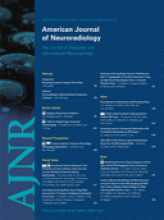Abstract
BACKGROUND AND PURPOSE: Prenatal drug exposure may influence the developing brain. Our aim was to study WM characteristics with DTI in children with prenatal opiate and polysubstance exposure and in controls. We assessed whether group differences in FA, DA, and DR could be found and related to cognitive function.
MATERIALS AND METHODS: The study was approved by a committee for medical research ethics. Parents signed an informed consent; children gave spoken consent. Our sample included 14 prenatally substance-exposed adopted children (5 girls; age range, 8.6–13.9 years; mean, 11.3 ± 1.7 years) and 14 control children (7 girls; age range, 9.0–10.2 years; mean, 9.8 ± 0.3 years). Tract-based spatial statistics were used to define a common WM skeleton for the sample, and FA was compared between groups throughout the skeleton, controlling for age and sex. Clusters of significant group differences ≥100 voxels (P <. 05) were identified. FA, DA, and DR within clusters were correlated with cognitive function.
RESULTS: Ten clusters of FA group differences, mostly in central, posterior, and inferior parts of the brain, were identified (P <. 05), showing lower FA in substance-exposed children. FA and DA correlated positively and DR, negatively with cognitive function across groups.
CONCLUSIONS: Prenatally substance-exposed children exhibited lower FA in restricted areas of WM, mostly relatively central, inferior, and posterior, where myelination occurs early in development. Myelin in these areas may be particularly vulnerable to prenatal substance exposure. FA and DR related moderately to cognitive function. Potential confounding factors existed and were considered.
Abbreviations
- ADHD
- attention deficit/hyperactivity disorder
- ANOVA
- analysis of variance
- AS
- Asperger syndrome
- ATRL
- anterior thalamic radiation, left
- ATRR
- anterior thalamic radiation, right
- CC
- corpus callosum
- CGL
- cingulum gyrus, left
- CGR
- cingulum gyrus, right
- CHL
- cingulum hippocampal part, left
- CHR
- cingulum hippocampal part, right
- CNS
- central nervous system
- CSTL
- corticospinal tract, left
- CSTR
- corticospinal tract, right
- DA
- axial diffusion
- DR
- radial diffusion
- DTI
- diffusion tensor imaging
- FA
- fractional anisotropy
- FASD
- fetal alcohol spectrum disorders
- FFD
- freedom from distractibility
- Fmaj
- forceps major
- Fmin
- forceps minor
- FMRIB
- Functional MRI of the Brain
- GCI
- general cognitive index
- GLM
- general linear model
- ILF
- inferior longitudinal fasciculus
- ILFL
- inferior longitudinal fasciculus, left
- ILFR
- inferior longitudinal fasciculus, right
- IQ
- intelligence quotient
- L
- left
- PPS
- Perceptual Performance Scale
- R
- right
- SES
- socioeconomic status
- SLF
- superior longitudinal fasciculus
- SLFL
- superior longitudinal fasciculus, left
- SLFR
- superior longitudinal fasciculus, right
- UF
- uncinate fasciculus
- UFL
- uncinate fasciculus, left
- UFR
- uncinate fasciculus, right
- WISC-R
- Wechsler Intelligence Scale for Children-Revised
- WM
- white matter
- Copyright © American Society of Neuroradiology
Indicates open access to non-subscribers at www.ajnr.org







